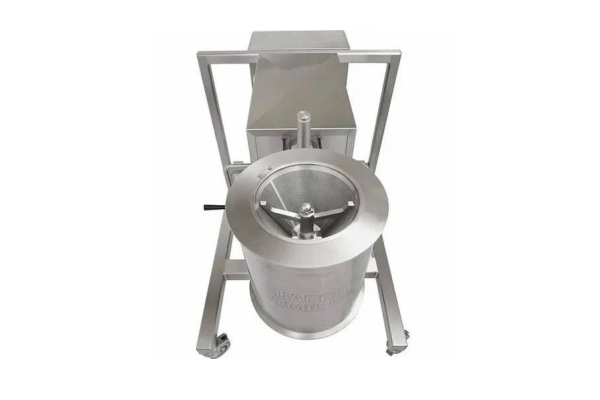MACHINE DESCRIPTION
It has the online CO-Mill on the discharge port that reduces the oversized lumps. It results in a reduction of drying time by approximately 20%. As the lumps are small products, they can be uniformly dried at lower temperatures. Hence providing it a longer shelf life and eliminating casing & capping of tablets due to improper drying.
WORKING PRINCIPLE
Cone-Mill is designed for low heat, low sound, low energy consumption operation and speed variation. Particles fall from the hopper into the blades of the mill which are moving at a very high RPM. The impact of the blades on the particles is the cause of the sizing. The blade has sharp edge on one side and blunt on the other. During Co mill operation product is poured into the feed hopper of the Co Mill. In the conical screen chamber, a rotating impeller imparts a vortex flow pattern to the in-feed product. The product is forced outward to the screen surface by centrifugal acceleration, ensuring continuous delivery into the "action zone" between the screen and impeller. No heating of product during granulation, due to better air circulation and lesser impact action. In the "action zone" the material is uniformly sized and instantaneously passed tangentially through the screen openings. The finished product is discharged at the bottom of the milling chamber. Cone mills used for achieving de-lumping, dispersion, Deagglomeration, fine grinding, dry and wet milling uniform size reduction, sieving and mixing in the pharmaceutical, food, fine chemical, personal care and cosmetics industries.The output of co mill is near to the size of sieve used approx. 80%-90%.Adjustable clearance between rotor and cone sieve.
Co Mills extend the Gericke range for producing fine to very fine powders (6 mm - 150 µ). Cone Mills are used for granulation processes with small particle size distribution at the end of production processes and before filling plants.
SALIENT FEATURES
- All contact parts can be easily and quickly dismantled and cleaned.
- Machine is designed for continuous operation.
- Conical screen for higher output.
- Castors provided for mobility.
- Beater of SS 316 quality.
OPTIONA
- FLP & NFLP construction.
- Tailor made construction.
- Extra sieve up to 12 mm hole size.
GENERAL POINTS
- All product contact parts shall be of SS 316 & non-contact parts shall be of SS 304, unless otherwise specified.
- Power requirement is 3Ph/415VAC/50Hz.
- All electrical shall be of FLP construction.
- All electrical switch gears shall be of C&S / L&T / Siemens make.
Conical Structure
The mill's conical shape allows for the material to be fed in at a larger diameter and then progressively reduced as it moves towards the smaller diameter exit.
Rotating Impeller
A high-speed impeller (or impeller blades) is positioned within the conical chamber. This impeller rotates at a set speed and forces the material against the conical screen.
Conical Screen
The screen is a perforated surface where the desired particle size can pass through.
Shearing and Attrition
As the material is forced against the screen, it undergoes shearing and attrition due to the high-speed rotation of the impeller. This process breaks down the material into smaller particles.
Particle Size Control
The size of the particles can be controlled by adjusting factors such as the impeller speed, the gap between the impeller and the screen, and the mesh size of the screen.
Material Handling
The mill can be fed via gravity (e.g., using an IBC bin) or vacuum. The sieved material is then collected in a receptacle or vacuum conveyed to the next process.
